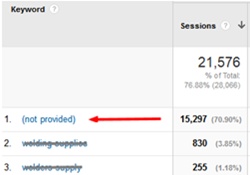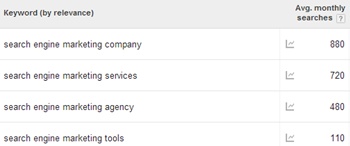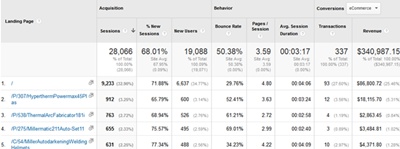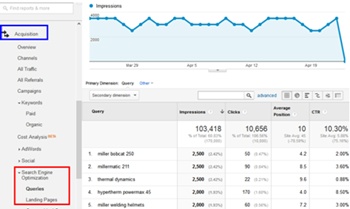


(not provided) Keywords in Google Analytics: 3 Workarounds
Strategies for Getting Around “Not Provided” for Keyword Research
BY: Steven Scott
 Our Milwaukee SEO company has developed and employed unique strategies to a growing concern among search engine marketers. This concern, more accurately a crisis, is the “Not Provided” seen more and more frequently in Google Analytics. If you are unfamiliar with “Not Provided” it is when Google does not give you the keywords users typed in before arriving at your site. Search engine marketing has always been based on the inclusion of keywords and keyword phrases. Search engine marketers optimize websites using relevant keywords to attract visitors/buyers. Since Google is no longer revealing a large chunk of these keywords, it’s becoming increasingly difficult for search engine marketers to optimize their websites for targeted traffic. Search engine marketers across the globe are proclaiming the death of search engine marketing. While most search engine marketers are preparing for the funeral and in complete crisis mode, our Milwaukee SEO company has created strategies to mine profitable data and resurrect search engine optimization (SEO). Our Milwaukee SEO experts creatively adapt, thrive and grow in the ever changing game of SEO.
Our Milwaukee SEO company has developed and employed unique strategies to a growing concern among search engine marketers. This concern, more accurately a crisis, is the “Not Provided” seen more and more frequently in Google Analytics. If you are unfamiliar with “Not Provided” it is when Google does not give you the keywords users typed in before arriving at your site. Search engine marketing has always been based on the inclusion of keywords and keyword phrases. Search engine marketers optimize websites using relevant keywords to attract visitors/buyers. Since Google is no longer revealing a large chunk of these keywords, it’s becoming increasingly difficult for search engine marketers to optimize their websites for targeted traffic. Search engine marketers across the globe are proclaiming the death of search engine marketing. While most search engine marketers are preparing for the funeral and in complete crisis mode, our Milwaukee SEO company has created strategies to mine profitable data and resurrect search engine optimization (SEO). Our Milwaukee SEO experts creatively adapt, thrive and grow in the ever changing game of SEO.
Using the Google Keyword Planner
Search engine marketers use specialized keyword research programs in order to better understand which keywords to target for their specific industry or niche. The most commonly used keyword tool is the Google Keyword Planner. This SEO tool gives you keyword ideas to focus on in your search engine marketing. For each keyword, it provides the average volume of people who search for it.
 You can filter your results by country, state, city, etc. to help refine your search terms to a more specific region.
You can filter your results by country, state, city, etc. to help refine your search terms to a more specific region.
SEO marketers start with the Keyword Planner, optimize their site accordingly, then check Google Analytics to track the success of the keywords which were implemented. In Google Analytics you can see the actual keywords driving traffic to your website. In other words the Keyword Planner is theoretical. Search engine marketers create strategies based on the keyword data found in the planner. The results in Google Analytics show what real website visitors are typing into the search engines to reach your website. Our Milwaukee search engine marketers have been using this real keyword data for years.
What is “Not Provided” in Google Analytics?
Since October 2011, Google stopped showing keyword specific data to SEO marketers. Google did this to “protect” the privacy of users. This includes people
- who are logged into their Gmail account
- searching Google securely using https instead of http
- using the “omnibox” (address bar search box) in Chrome or Firefox
- and other users Google has not yet specified
Under these circumstances you will not see the keyword phrases the user typed in to get to your website. Some suggest 83% of search terms are now rendered “Not Provided”. While this limits the arsenal of tools SEO marketers can use to drive traffic to their site, there are other highly valuable alternatives.
3 Profitable Strategies to Make Google’s “Not Provided” a Non-Issue
-
Extrapolating Keyword Provided Data - Even though approximately 80% of the keyword data is blocked, you can still see the data for 20% of your visitors. You can use the keyword data from 20% of your visitors as a representative sample of the “Not Provided”. By viewing data for these keywords you can see which keywords visitors are using to arrive at your site and analyze their behavior including bounce rate, contact page submissions, sales, etc.
- Use Search Engine Optimization within Google Analytics - You can still use the Search Engine Optimization tab under Acquisition. This shows which keywords rank the highest, have the highest number of impressions, the highest click through rate and best average positions. This tool allows you to see which keywords are driving the most traffic and how your position for each keyword is increasing over time.
-
Using Landing Page Data - Landing pages getting the most traffic are another great indicator of what your visitors are interested in. Landing pages also reflect which pages are working in your favor based regarding optimization tactics. In Google Analytics you can see which pages receive the most visitors from search traffic.
You can see which landing pages on your website have the most visits, longest session duration, lowest bounce rate, highest revenue and more. Using this data offers a good estimate on keywords people are interested in based on the landing pages from which they enter. Knowing what keywords those pages are optimized for will give you an idea as to what keywords people are using to find your site. This information is invaluable and unaffected by Google’s new “Not Provided”.
 Our Milwaukee SEO Specialists Outwit Google’s “Not Provided,” Increasing Our Clients’ Website Traffic
Our Milwaukee SEO Specialists Outwit Google’s “Not Provided,” Increasing Our Clients’ Website Traffic
Our Milwaukee SEO experts adapt to the changes and utilize data in innovative ways to help drive your website to the top of search engine rankings. Search engine marketing companies who complain about the changes and don’t adapt will not survive. INET has a team of Milwaukee SEO experts who are always up-to-date on cutting edge strategies for driving traffic and increasing client revenue.


